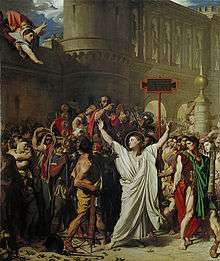Symphorian and Timotheus
- Symphorian is also the name of one of the Four Crowned Martyrs. For various places in France and Belgium, see Saint-Symphorien.
| Saints Symphorian and Timotheus | |
|---|---|
|
| |
| Martyrs | |
| Died | August 22, 178 |
| Venerated in | Catholic Church |
| Canonized | Pre-Congregation |
| Major shrine | Autun |
| Feast | August 22 |
| Attributes | Symphorian is depicted as a young man being dragged to martyrdom while his mother encourages him. |
| Patronage | Symphorian is patron of Autun; children; students; against eye problems, against syphilis |
Symphorian (Symphorianus, Symphorien), Timotheus (Timothy), and Hippolytus of Rome are three Christian martyrs who though they were unrelated and were killed in different places and at different times, shared a common feast day in the General Roman Calendar from at least the 1568 Tridentine Calendar to the Mysterii Paschalis.
Symphorian
According to a legend of the early 5th century, St. Symphorian of Autun was beheaded, while still a young man, during the reign of Marcus Aurelius. He was the son of a senator named Faustus. He studied at Autun and was brought before the provincial governor Heraclius for not worshipping the pagan goddess Cybele. Symphorian is said to have asked for tools to destroy the statue. He was arrested and flogged and, because he was from a noble family, he was given a chance to recant. Symphorian was offered bribes to do so, but he declined.
His mother, the Blessed Augusta (?), encouraged him on his way to execution, 22 August 178, and was present at her son's death. In the oldest redaction of manuscripts containing the saint's life we find a Gaulish sentence recorded that she allegedly yelled from the city wall: nate, nate, synphoriane, mentobeto to diuo which may be read as "gnate, gnate, mentobe to diwo[1] " "son, son, o synphorian, remember your god!".[2]
According to a legendary passio of St. Benignus of Dijon, Symphorian was a young nobleman who was converted by Benignus at Autun.
Veneration
Bishop Euphronius (died 490) built a handsome church over Symphorian's grave, connected with a monastery, which belonged to the Congregation of Sainte-Geneviève from 1656 until its suppression in 1791. Abbot Germanus later became Bishop of Paris, where he dedicated a chapel to the saint. Genesius of Clermont built a church dedicated to him at Clermont.
St. Symphorian is the patron saint of Autun. His veneration spread at an early date through the empire of the Franks. His cult was especially popular at Tours; St. Gregory of Tours relates a miracle wrought by the saint.
There is a St. Symphorian's Church at Veryan, Cornwall and another at Durrington in West Sussex, now a suburb of the town of Worthing.
Timotheus
During the pontificate of Melchiades (311–13), St. Timotheus came from Antioch to Rome, where he preached for fifteen months and lived with Sylvester, who later became pope. The prefect of the city, Tarquinus Perpenna, threw him into prison, tortured, and finally beheaded him in 311. A Christian woman named Theon buried him in her garden. This is related in the legend of Sylvester. The name of Timotheus occurs in the earliest martyrologies.
Hippolytus
The 22 August feast of Saint Hippolytus of Rome was a duplicate of his 13 August feast and for that reason was deleted when the General Roman Calendar was revised in 1969.[3] Earlier editions of the Roman Martyrology referred to the 22 August Hippolytus as Bishop of Porto. The Catholic Encyclopedia sees this as "connected with the confusion regarding the Roman presbyter resulting from the Acts of the Martyrs of Porto. It has not been ascertained whether the memory of the latter was localized at Porto merely in connection with the legend in Prudentius, without further foundation, or whether a person named Hippolytus was really martyred at Porto, and afterwards confounded in legend with Hippolytus of Rome."[4] This opinion is shared by a Benedictine source.[5]
See also
- Saint-Symphorien, places in France named for Symphorian (French: Symphorien)
References
| Wikimedia Commons has media related to Symphorian. |
- ↑ Thurneysen, Rudolf (1923). "Irisches und Gallisches". Zeitschrift für celtische Philologie. 14: 1–17.
- ↑ R. Thurneysen, "Irisches und Gallisches," in: Zeitschrift für celtische Philologie 14 (1923) 1-17.
- ↑ Calendarium Romanum (Libreria Editrice Vaticana, 1969), p. 135
- ↑ Catholic Encyclopedia:Sts. Hippolytus
- ↑ Saint of the Day, 22 August
External links
- Symphorian and Timotheus at the Catholic Encyclopedia
- Patron Saints Index: Symphorian
- Saint of the Day, August 22: Symphorian of Autun at SaintPatrickDC.org
![]() This article incorporates text from a publication now in the public domain: Herbermann, Charles, ed. (1913). "Sts. Timotheus and Symphorian". Catholic Encyclopedia. New York: Robert Appleton.
This article incorporates text from a publication now in the public domain: Herbermann, Charles, ed. (1913). "Sts. Timotheus and Symphorian". Catholic Encyclopedia. New York: Robert Appleton.
